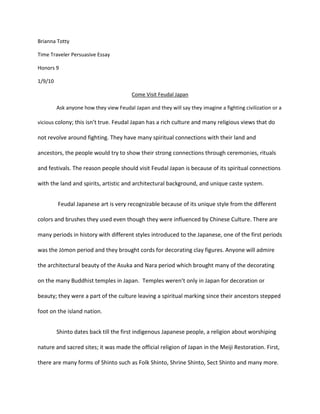
Persuasive essay japan
- 1. Brianna Totty <br />Time Traveler Persuasive Essay<br />Honors 9<br />1/9/10<br />Come Visit Feudal Japan<br />Ask anyone how they view Feudal Japan and they will say they imagine a fighting civilization or a vicious colony; this isn’t true. Feudal Japan has a rich culture and many religious views that do not revolve around fighting. They have many spiritual connections with their land and ancestors, the people would try to show their strong connections through ceremonies, rituals and festivals. The reason people should visit Feudal Japan is because of its spiritual connections with the land and spirits, artistic and architectural background, and unique caste system. <br /> Feudal Japanese art is very recognizable because of its unique style from the different colors and brushes they used even though they were influenced by Chinese Culture. There are many periods in history with different styles introduced to the Japanese, one of the first periods was the Jōmon period and they brought cords for decorating clay figures. Anyone will admire the architectural beauty of the Asuka and Nara period which brought many of the decorating on the many Buddhist temples in Japan. Temples weren’t only in Japan for decoration or beauty; they were a part of the culture leaving a spiritual marking since their ancestors stepped foot on the island nation. <br />Shinto dates back till the first indigenous Japanese people, a religion about worshiping nature and sacred sites; it was made the official religion of Japan in the Meiji Restoration. First, there are many forms of Shinto such as Folk Shinto, Shrine Shinto, Sect Shinto and many more. Shinto shrines are like an altar to the Christian people, the shrines were believed to hold spirits that represented the gods which made the land and whoever wanted to visit these gods needed to be purified three times before visiting. Not only is it an interesting religion but it lasted for a very long time even after the Feudalism period ended Shinto is still a popular Religion in Japan right next to Buddhism. Shinto wasn’t the only unique thing about Feudal Japan, there are many things that make this nation stand out in the viewers eyes such as its caste system.<br />Emperor, shogun, daimyo, samurai, peasants and merchants make up Feudal Japans Caste System. Most people won’t be very interested about social class; however Feudal Japan’s system isn’t like others, for starters most people think the Emperor is the highest rank but that’s wrong, Shoguns and Daimyos can surpass the Emperor with power. Different sections of Japan are named after the ruling Daimyos of the time, not after the Emperor who acts more like a finger puppet then a political leader. Samurai’s are considered higher class then the lower class which consist of peasants and merchants who are looked down upon by other people. Learning about the caste system is a good way of trying to see what it was like living in Feudal Japan and being able to place yourself among the ranks. Learning about the culture of one place isn’t the same as Learning about Feudal Japan because none compare to its culture and richness. <br />What makes Feudal Japan different from other ancient cultures is the fact that’s its memorable. There are so many references in the world at Feudal Japan because of this alluring culture and the fact that there really is no other civilization like it. Feudal Japan doesn’t really have a signature invention like the Aztecs or Mayans, it doesn’t have a literature like the ancient Greeks or Romans but, visitors will not be disappointed at the exotic beauty of the decorations that run across Feudal Japan’s temples and buildings, or the fact that Feudal Japan’s beauty isn’t hidden behind a mask of inventions or its culture being interrupted by a philosophers view, no all it takes is a look at one of the Shinto shrines sitting upon a lake bed with Mount Fuji behind and realizing its beauty comes from the nature and architect. <br />Feudal Japan isn’t all about sword fights or ninja attacks, it isn’t about inventions or philosophers. It’s about looking deep inside the culture and realizing that not does political power make a country but also deep connections in the land which they come from. <br />Citied Pages<br />quot; Religion in Japan.quot; Japan-guide.com - Japan Travel and Living Guide. Web. 27 Apr. 2011. <http://www.japan-guide.com/e/e629.html>.<br />quot; BBC - Religion: Shinto.quot; BBC - Homepage. Web. 27 Apr. 2011. <http://www.bbc.co.uk/religion/religions/shinto/>.<br /> <br />quot; Art in Japan: Feudal Arts and Architecture.quot; Japan Travel Guide - Travel to Japan. Web. 27 Apr. 2011. <http://www.justjapan.org/japan/art/japan-feudal.asp>.<br />